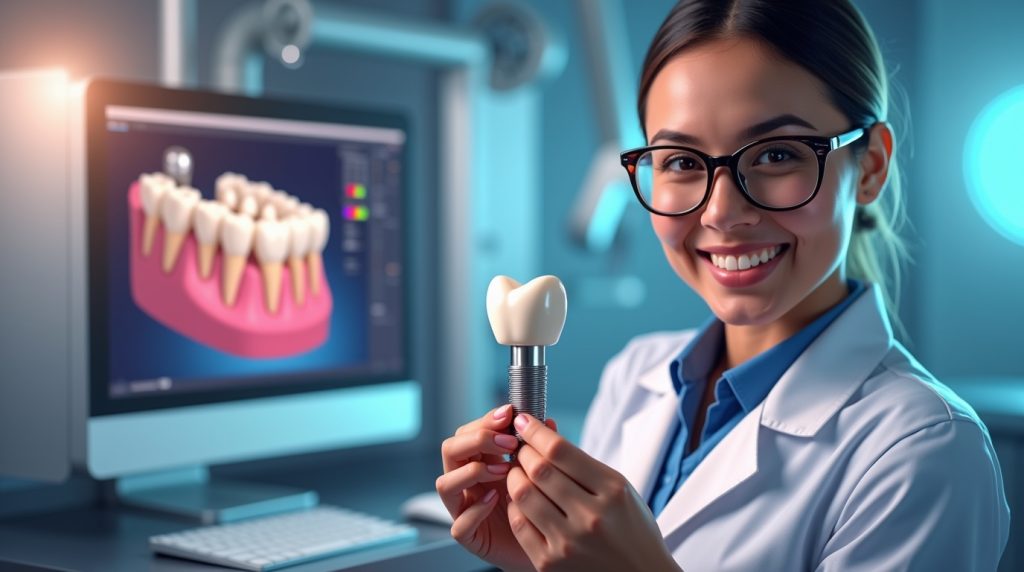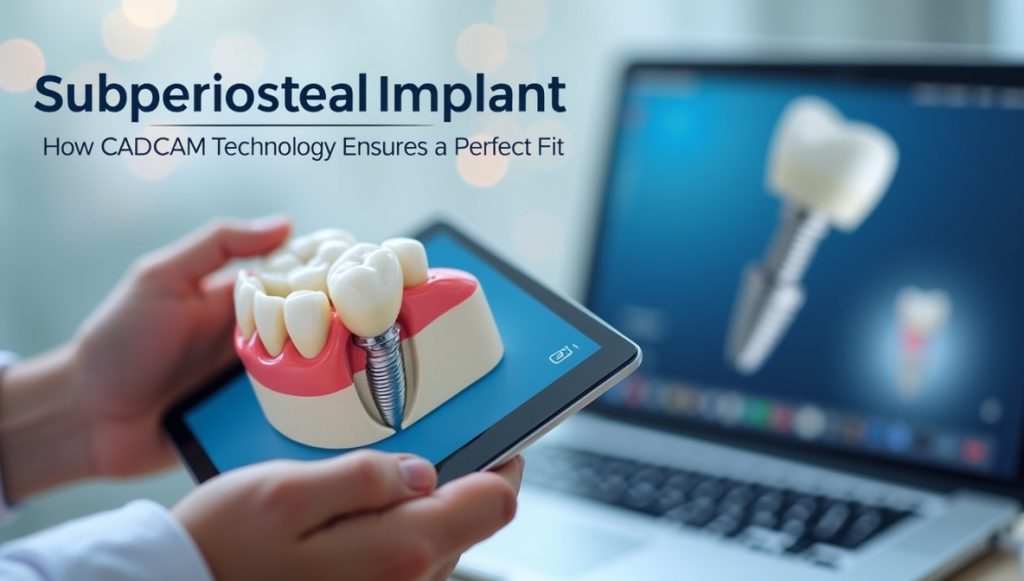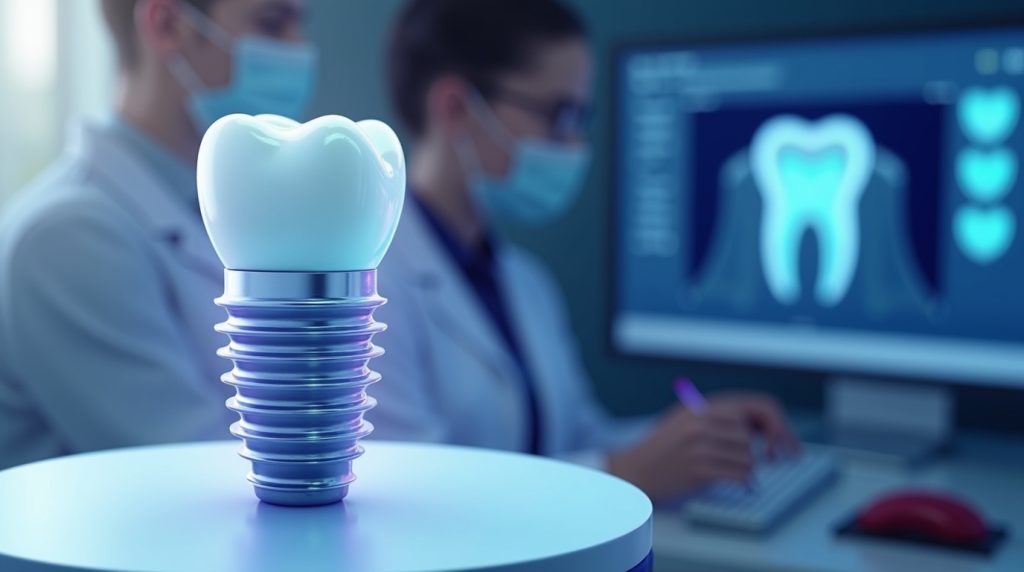Traditional dental implants aren’t a good option for patients who have lost large portions of their jawbone. Extensive bone grafting, prolonged healing times, and long surgeries can be some of the challenges. However, a revitalized dental technique, powered by modern technology, is offering new standards for subperiosteal implants, and thanks to CAD/CAM dentistry, it’s making a remarkable comeback.
What is a subperiosteal implant? It’s a custom-made metal framework that rests on top of the jawbone, just beneath the gum tissue. This novel approach effectively anchors dentures without having to drill deep into the jaw. While this idea was already circulating for several decades, recent developments in digital imaging and production have made it a highly safe, accurate, and extremely effective treatment for bone resorption.
In this blog, we’re going to discuss the evolution of subperiosteal implants, how computer-guided CAD/CAM technology creates the perfect fit, and why you might want to choose this solution for complex dental rehabilitation.
Key Takeaways
- Traditional dental implants may not suit patients with significant jawbone loss, but subperiosteal implants offer an effective alternative.
- Subperiosteal implants utilize a custom metal framework placed atop the jaw, avoiding the need for extensive drilling.
- CAD/CAM technology revolutionizes the design and manufacturing of these implants, leading to greater accuracy and faster treatment times.
- Ideal candidates for subperiosteal implants include those with advanced bone loss, those avoiding bone grafting, and individuals needing quicker results.
- Modern subperiosteal implants show high success rates and present a less invasive option for complex dental rehabilitation.
Table of Contents
A Brief History of Subperiosteal Implants
The idea of a subperiosteal implant is not new. Dr. Gustave Dahl invented subperiosteal dental implants in the 1940s, originally developing them for edentulous patients, especially those with severe bone atrophy that made traditional endosteal implants ineffective.
But early subperiosteal dental implants had their drawbacks. The surgery was difficult; often, imprints of the exposed jawbone had to be taken directly for the implant foundation. This resulted in problems with the fit, high infection rates, and placement difficulties of an implant. Subperiosteal implants have been relegated to the background, with osseointegration and endosteal implants becoming more widely accepted.
Now, the subperiosteal implant is making a comeback, but this time around, the technology behind it has come of age. Precision engineering has overcome the limitations that once held it back, making it a leading-edge solution once again.

The Role of CAD/CAM in Modern Dentistry
For the subperiosteal implant, a revolution in its design has been due to Computer Aided Design/Computer Aided Manufacturing (CAD/CAM) technology. This digital pathway means custom subperiosteal implants are no longer a process of oral impressions and invasive procedures, but accurate, non-interventional digitized scans.
Here is how CAD/CAM dentistry operates in this setting:
- Digital Imaging: Beginning with a 3D Cone-Beam Computed Tomography (CBCT) scan of the patient’s jaw. This gives an accurate 3D model of the bony structure without physical impressions.
- Virtual Design: In this second step in the process, a dental technician uses specialized CAD software to create a 3D printed subperiosteal implant that fits perfectly to the unique anatomical shape of their jaw. This subperiosteal implant design stage leads to the best abutment positions and, therefore, prosthetic results.
- Precision Fabrication: A CAM system receives the digital design and creates the subperiosteal implant using methods such as 3D printing or precision milling of a block of medical-grade titanium.
This method causes a perfect fit that is essential for the stability and success of the subperiosteal implant in the long term.
Benefits of Subperiosteal Implants with CAD/CAM Technology
The inclusion of CAD/CAM in the design and fabrication of subperiosteal implants presents a number of compelling benefits to both Dentistry and the patient.
- Precision: No other type of dental implant achieves the fine precision (in microns) that the subperiosteal implant does. This accuracy leads to shorter and safer procedures.
- More Conservative: As the implant is planned from a CBCT, that means we no longer need a surgical impression of the bone. This makes for a less traumatic overall subperiosteal implant process for the patient.
- Fast Treatment Times: The compact digital workflow that runs from scanning to milling is extremely time-efficient. This, added to the prospect of immediate/early loading, often makes for a shorter overall treatment time as opposed to providing bone grafts in traditional protocols.
- Predictable Outcomes: With digital planning, surgeons can see what the result will look like before they even begin surgery. This improves predictability and results in a subperiosteal implant that serves functional and esthetic purposes.
Accuracy of Fit: CAD/CAM vs. Traditional Methods
The precision offered by CAD/CAM is a significant leap forward from historical techniques.
| Technology | Accuracy of Fit (Average Discrepancy) | Source of Data |
|---|---|---|
| CAD/CAM Subperiosteal Implants | ~50 microns | Finite Element Analysis & Clinical Studies |
| Traditional (Casted) Implants | >150 microns | Historical Dental Literature |
This table illustrates how CAD/CAM dentistry provides a superior fit, which is crucial for implant stability and reducing soft tissue irritation.
Who Is an Ideal Candidate for a Subperiosteal Implant?
A subperiostal implant is a great choice for specific sets of patients. Subperiosteal implant indications primarily include:
- Patients with Advanced Bone Loss: Anyone who has experienced substantial bone recession, such as from tooth loss, gum disease or injury, can benefit. This is an important choice for the treatment of bone resorption.
- Those Unwilling or Unable to Undergo Bone Grafting: For patients who want to avoid the additional surgery, cost, and long healing times associated with bone grafting, a subperiosteal dental implant is a compelling alternative.
- Individuals Seeking Faster Results: When compared to the lengthy process of grafting followed by implant placement, the subperiosteal implant procedure can deliver a restored smile much more quickly.
- Anatomical Limitations: In cases where vital structures like nerves or sinuses make traditional subperiosteal and endosteal implants risky, the on-the-bone placement of a subperiosteal implant is a safer approach for the subperiosteal implant mandible.
Adapting completely to such challenging treatment approaches, AB Dental introduce PSI (Patient-Specific Implant), which provides a trusted route to full-arch rehabilitation even in extremely atrophic jaws.

The Subperiosteal Implant Procedure: A Step-by-Step Look
Careful surgical technique is crucial when inserting the subperiosteal implant and relies on the accuracy of CAD/CAM design.
- First Visit & CT-SCAN: A Comprehensive clinical evaluation and CBCT scan are acquired.
- Design & Production of Implants: Designers digitally design and construct the personalized template in medical titanium.
- Surgical Procedure: An incision is performed by the surgeon to uncover my jaw. The surgeon directly installs the tailored subperiosteal implant on the bone and holds it in place with small fixation screws. Unlike endosteal implants, dentists do not extensively drill into the bone with this type of implant.
- Soft Tissue Closure: The gum is sewn up over the top, with little stubs sticking out. These posts hold the completed dental prosthesis in place.
- Prosthetic Restoration: Once the soft tissues have healed, the dentist cements a permanent bridge or denture to the posts.
Materials Matter: Titanium for Strength and Biocompatibility
Manufacturers construct most contemporary subperiosteal dental implants using either pure or alloyed titanium. This material is selected for several important reasons:
- Biocompatibility: The body accepts titanium, which lowers both rejection and allergic or negative responses.
- Strength and Durability: Slim-line titanium is an extremely strong, lightweight material that can endure the forces in your mouth from smiling, talking and chewing over a long period.
- Osseointegration Characteristics: The surface of titanium implants, especially with modern enhancements such as those utilised on PSI by AB Dental, stimulates cellular activity and assimilation into adjacent tissues.
Success Rates: The New Era of Subperiosteal Implants
With the addition of CAD/CAM dentistry and better surgical procedures, we now have a high success rate with the subperiosteal implants. Historical implants had survival rates of over the long-term that could be at 50-60% by 15 years. Modern implants, by contrast, have a very different tale to tell.
| Study Period | Survival Rate (CAD/CAM Implants) | Survival Rate (Traditional Implants) |
|---|---|---|
| 5 Years | >95% | ~92% |
| 7-10 Years | ~98% (in some studies) | ~82% |
| 15 Years | Data Emerging | 50-60% |
A 2023 trial reported a 98% survival rate at seven years for modern designs. Additionally, AB Dental’s PSI solution has consistently achieved these high success rates when used in actual patient cases, yielding durable long-term results.
Subperiosteal Implants vs. Traditional Implants
Knowing the distinction between endosteal versus subperiosteal implants is crucial to better appreciate the distinctive nature of this technology.
| Feature | Subperiosteal Implant | Endosteal (Traditional) Implant |
|---|---|---|
| Placement | On top of the jawbone, under the gum | Drilled into the jawbone |
| Bone Requirement | Minimal bone volume required | Sufficient bone height and width are needed |
| Bone Grafting | Typically avoided | Often required for patients with bone loss |
| Invasiveness | Less invasive to the bone | More invasive due to drilling |
| Ideal Candidate | Severe bone resorption | Adequate bone structure |
The growing subperiosteal dental implants market reflects its value as a distinct and necessary tool in modern implantology.

A Brighter Future with Revitalized Technology
The subperiosteal implant has been reborn, powered by the wonders of CAD/CAM dentistry, and is a quantum leap forward in treating patients who have profound bone atrophy. It offers a minimally invasive, immediate, but predictable alternative to invasive transplantation operations.
Nowadays, with systems like AB Dental PSI (Patient Specific Implant), no patient should leave the clinic without a functional and aesthetic smile in any situation. This reinvigorated technique is not only an antique; it demonstrates what innovation can do to rejuvenate those proven concepts, and it enlarges the horizons for dental rehabilitation.
FAQs
The subperiosteal implant rests on top of the jawbone (underneath the gum tissue) rather than being drilled down into it, as is done with an old-fashioned endosteal implant. Dentists mostly use it when a patient does not have sufficient bone height for standard implants.
CAD/CAM technology records digital images to generate a custom-fitted metal framework that mirrors the patient’s anatomical landmarks. Additionally, this makes for a more secure/comfortable fit and minimizes post-op adjustments.
Subperiosteal implants provide an ideal solution for patients who cannot or do not want bone augmentation and lack enough gum to support a denture.
Digital designing and fabrication usually take a week or two, while surgeons complete the placement in a single visit, which is faster than multi-step traditional implant protocols.
Accurate design gives these implants good stability, a tailored fit, and a high success rate. They help reduce discomfort and promote faster recovery time as opposed to other techniques.











